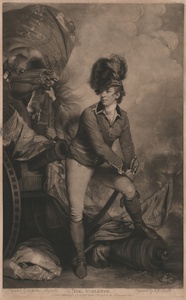| Method | Mezzotint |
| Artist | John Raphael Smith after Sir Joshua Reynolds |
| Published | London Publish'd Oct,,r 11 1782 by J.R. Smith No 83 opposite the Pantheon Oxford Street. |
| Dimensions | Image 624 x 393 mm, Plate 692 x 394 mm, Sheet 654 x 410 mm |
| Notes |
A whole length portrait of Sir Banastre Tarleton standing, with his left foot on a cannon, looking towards left wearing uniform and a plumed hat, drawing his sword, horses and groom to left, with a British Legion flag flying above. It is worth noting that Tarlerton's pose obscures his hands as he lost two fingers to a musket ball in the Battle of Guilford Court House. Sir Banastre Tarleton, 1st Baronet GCB (1754 – 1833) was a British general and Whig politician best known as the lieutenant colonel leading the British Legion at the end of the American Revolutionary War. He was the third son of seven children of the Liverpool merchant and slave trader John Tarleton and his wife Jane Parker. Educated at University College, Oxford and then Middle Temple, Tarleton inherited £5000 upon his father's death in 1773 which he squandered in less then a year on gambling and women. In 1775, he purchased a commission as a calvary officer in the 1st Dragoon Guards. A talented horseman, Tarleton rose to be lieutenant colonel on his own merit. In 1775, he volunteered to join the British troops fighting in the American War of Independence. During his six year service in the war Tarleton he was promoted to lieutenant-colonel in 1781. Tarleton returned to England at the age of 27 an injured, but triumphant war hero, despite the British's defeat in the Revolution. He sat for three portraits by the country's leading artists: Thomas Gainsborough, Sir Joshua Reynolds, and Richard Cosway. Tarleton continued to serve in the British Army ultimately becoming the general of the 1st Dragoon Guards on January 1, 1812. In addition to his military career, Tarleton served as MP for Liverpool 1790 -1812, where he spoke against the abolition of the slave trade and on military matters. He was in a 15 year relationship with actress, writer, and early feminist Mary 'Perdita' Robinson. John Raphael Smith (1751 - 1812) was an English painter, printmaker and publisher. After abandoning a career in linen drapery, Smith became one of the leading printmakers of the day. He excelled in mezzotint, and produced numerous plates after portraits by Gainsborough, Reynolds, and Romney. In addition to his reproductive work, he was also a highly successful publisher and seller of prints, and exported a large number of material to France. However, the outbreak of the Napoleonic Wars in 1803 destoyed this market, and Smith announced his retirement from printmaking in order to produce pastel portraits of his own up until his death in 1812. Sir Joshua Reynolds (1723-1792) was one of the most important figures of the eighteenth century art world. He was the first President of the Royal Academy and Britain's leading portrait painter. Through a series of lectures on the Discourses on Art at the Royal Academy he defined the style later known as the Grand Manner, an idealised Classical aesthetic. He had a profound impact on the theory and practice of art and helped to raise the status of portrait painting into the realm of fine art. A flamboyant socialite, Reynolds used his social contacts to promote himself and advance his career becoming one of the most prominent portrait painters of the period. Chaloner Smith 161 ii/iii, Russell 161 iv/v, Frankau - J.R. Smith 345, Hamilton p 67, D'Oench 202, O'Donoghue 2, Alexander and Godfrey 1980 71, Lennox-Boyd iv/v Condition: Some overall toning to the paper, old paper hinging tape to the left verso, some minor spotting, and a repaired tear with staining to the middle right margin just into the image. |
| Framing | unmounted |
| Price | £900.00 |
| Stock ID | 52572 |

